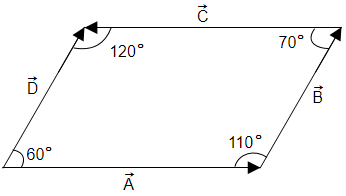Two forces, \(1\) N and \(2\) N, act along with the lines \(x=0\) and \(y=0\). The equation of the line along which the resultant lies is given by:
1. \(y-2x =0\)
2. \(2y-x =0\)
3. \(y+x =0\)
4. \(y-x =0\)
1. \(y-2x =0\)
2. \(2y-x =0\)
3. \(y+x =0\)
4. \(y-x =0\)
If the angle between the vector is , the value of the product is equal to:
1.
2.
3.
4. zero
| Assertion (A): | The graph between \(P\) and \(Q\) is a straight line when \(\frac{P}{Q}\) is constant. |
| Reason (R): | The straight-line graph means that \(P\) is proportional to \(Q\) or \(P\) is equal to a constant multiplied by \(Q\). |
| 1. | Both (A) and (R) are True and (R) is the correct explanation of (A). |
| 2. | Both (A) and (R) are True but (R) is not the correct explanation of (A). |
| 3. | (A) is True but (R) is False. |
| 4. | Both (A) and (R) are False |
Two forces are such that the sum of their magnitudes is \(18~\text{N}\) and their resultant is perpendicular to the smaller force and the magnitude of the resultant is \(12~\text{N}\). Then the magnitudes of the forces will be:
1. \(12~\text{N}, 6~\text{N}\)
2. \(13~\text{N}, 5~\text{N}\)
3. \(10~\text{N}, 8~\text{N}\)
4. \(16~\text{N}, 2~\text{N}\)
If the magnitude of the sum of two vectors is equal to the magnitude of the difference between the two vectors, the angle between these vectors is:
1. \(90^{\circ}\)
2. \(45^{\circ}\)
3. \(180^{\circ}\)
4. \(0^{\circ}\)
Six vectors \(\overrightarrow a ~\text{through}~\overrightarrow f\) have the directions as indicated in the figure. Which of the following statements may be true?
1. \(\overrightarrow b + \overrightarrow c = -\overrightarrow f\)
2. \(\overrightarrow d + \overrightarrow c = \overrightarrow f\)
3. \(\overrightarrow d + \overrightarrow e = \overrightarrow f\)
4. \(\overrightarrow b + \overrightarrow e = \overrightarrow f\)
In the given figure

| 1. | Angle between \(\overrightarrow {A}\) and \(\overrightarrow {B}\) is \(110^{\circ}\) |
| 2. | Angle between \(\overrightarrow {C}\) and \(\overrightarrow {D}\) is \(60^{\circ}\) |
| 3. | Angle between \(\overrightarrow {B}\) and \(\overrightarrow {C}\) is \(110^{\circ}\) |
| 4. | Angle between \(\overrightarrow {B}\) and \(\overrightarrow {C}\) is \(70^{\circ}\) |
A force of 6 N and another of 8 N can be applied together to produce the effect of a single force of -
(1) 1 N
(2) 11 N
(3) 15 N
(4) 20 N
Which of the sets given below may represent the magnitude of resultant of three vectors adding to zero?
(1) 2, 4, 8
(2) 4, 8, 16
(3) 1, 2, 1
(4) 0.5, 1, 2
A blind person after walking 10 steps in one direction, each of length 80 cm, turns randomly to the left or to the right by After walking a total of 40 steps the maximum possible displacement of the person from his starting position could be -
(1)
(2)
(3)
(4)







